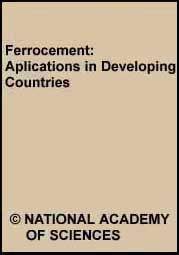
Ferrocement Applications in Developing Countries (BOSTID, 1973, 89 p.)
Ferrocement for Low- Cost Roofing
Rapid population growth and industrial development have created overwhelming demands on human settlements. A still greater burden will fall on cities, towns, and rural communities in the future. According to a recent U.N. estimate, the world population will double by the year 2000 to nearly 7 billion people,* while the world urban population will increase to more than 3 billion, or 51 percent of the total world population. The size of future housing requirements alone is staggering: during 1970-1980, Asia, Africa, and Latin America will need housing for 325 million people entering urban areas, at the rate of 90,000 people per day.** And these figures do not include the vast number of rural dwellings and new or modernized work places and public facilities that will be needed.
Developing countries already have acute housing shortages because of rapid population growth and, sometimes, disasters. Typical examples are Ceylon, 200,000 houses short; India, 11.9 million; Philippines, 3 million; Republic of (South) Korea, I million houses short in 1970 with demand continuing to grow at over 100,000 houses per year.
To these needs for basic housing to accommodate population increases and to improve housing quality must be added the periodic necessity to replace housing destroyed by natural disasters prevalent in the developing world. Earthquakes, typhoons, hurricanes, cyclones, floods, and fire take a vicious toll of tens of thousands of dwellings each year, as in Bangladesh, Peru, and Nicaragua.
Of the desperately needed new materials and construction methods, the most critical component is appropriate roofing. Under normal conditions in developing countries the roof of a dwelling structure constitutes the major expense, often as much as 60 percent of the total cost. For most people a long-lasting roof is too expensive. Yet, most roofs manufactured from cheaper local materials such as grass or reeds (thatch) or earth products (sand, mud, rock) are short-lived and dangerous in an earthquake, flood, or fire. Thatch is notorious for harboring vermin and insects. Furthermore, an adequate roof covering is often impractical because it needs a high-cost supporting structure. For instance, tiles make excellent roofs, but they are so heavy they require extensive supporting frames. In many regions, wooden supports decay rapidly, though the covering remains sound.
To satisfy their shelter needs, many developing countries expend scarce foreign exchange for galvanized iron and other metal roofings from Industrialized countries. However purchased, bulky metal sheets are expensive to transport within a country. In hot climates the heat absorption of metal roofs converts homes into ovens. Corrosion is also a problem, particularly where the metal is exposed to saltwater spray.
The previously described advantages of ferrocement for developing countries apply to roofing. Ferrocement appears to have decided advantages over several other roofing materials and could well play a major role in housing construction in developing countries. (See Figures 13-l S.)
Ferrocement roofing materials can be factory mass-produced in prefabricated form, a process best suited to the concentrated demand of urban areas. Though it might be more economical to mass-produce roofing in an urban factory and truck it to a rural area (should trucking be possible), ferrocement is also easily fabricated on site in rural areas, using local labor and materials.
Freer in concept and makeup than most conventional roofing, ferrocement can be shaped into domes, vaults, extruded shapes, flat surfaces, or free-form areas.
Before ferrocement can be used widely for roofing, research and experiments will be required to determine the shapes and types of roofing members to be manufactured, and to explore designs and methods for anchoring and bolting these various shapes to supporting walls.
After this research and experimentation is completed, on-thejob training centers may be required to introduce the new material and its new building techniques. Preferably, these centers should also offer programs dealing with other ferrocement applications.
Research efforts to find ferrocement modifications that prove less expensive or easier to manufacture are highly recommended. Possibly, for example, ferrocement can be sandwiched on two sides of a core of foam concrete or other lightweight material to make a less expensive and lightweight, yet still structurally strong, material.